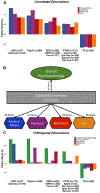Evidence for Dissociable Linkage of Dimensions of Psychopathology to Brain Structure in Youths
- PMID: 31230463
- PMCID: PMC6888993
- DOI: 10.1176/appi.ajp.2019.18070835
Evidence for Dissociable Linkage of Dimensions of Psychopathology to Brain Structure in Youths
Abstract
Objective: High comorbidity among psychiatric disorders suggests that they may share underlying neurobiological deficits. Abnormalities in cortical thickness and volume have been demonstrated in clinical samples of adults, but less is known when these structural differences emerge in youths. The purpose of this study was to examine the association between dimensions of psychopathology and brain structure.
Methods: The authors studied 1,394 youths who underwent brain imaging as part of the Philadelphia Neurodevelopmental Cohort. Dimensions of psychopathology were constructed using a bifactor model of symptoms. Cortical thickness and volume were quantified using high-resolution 3-T MRI. Structural covariance networks were derived using nonnegative matrix factorization and analyzed using generalized additive models with penalized splines to capture both linear and nonlinear age-related effects.
Results: Fear symptoms were associated with reduced cortical thickness in most networks, and overall psychopathology was associated with globally reduced gray matter volume across all networks. Structural covariance networks predicted psychopathology symptoms above and beyond demographic characteristics and cognitive performance.
Conclusions: The results suggest a dissociable relationship whereby fear is most strongly linked to reduced cortical thickness and overall psychopathology is most strongly linked to global reductions in gray matter volume. Such results have implications for understanding how abnormalities of brain development may be associated with divergent dimensions of psychopathology.
Keywords: Adolescents; Brain; Child Psychiatry; Cortical Thickness; Development; MRI.
Figures




Comment in
-
Controlling Fear Over the Lifespan.Am J Psychiatry. 2019 Dec 1;176(12):974-975. doi: 10.1176/appi.ajp.2019.19101037. Am J Psychiatry. 2019. PMID: 31787010 No abstract available.
References
Publication types
MeSH terms
Grants and funding
- R01 MH112847/MH/NIMH NIH HHS/United States
- R01 NS099348/NS/NINDS NIH HHS/United States
- R01 MH107235/MH/NIMH NIH HHS/United States
- R01 MH112070/MH/NIMH NIH HHS/United States
- K12 HD085848/HD/NICHD NIH HHS/United States
- RC2 MH089924/MH/NIMH NIH HHS/United States
- R01 MH113550/MH/NIMH NIH HHS/United States
- R00 MH117274/MH/NIMH NIH HHS/United States
- S10 OD023495/OD/NIH HHS/United States
- K99 MH117274/MH/NIMH NIH HHS/United States
- R01 NS085211/NS/NINDS NIH HHS/United States
- R01 MH107703/MH/NIMH NIH HHS/United States
- RC2 MH089983/MH/NIMH NIH HHS/United States
LinkOut - more resources
Full Text Sources
Medical

